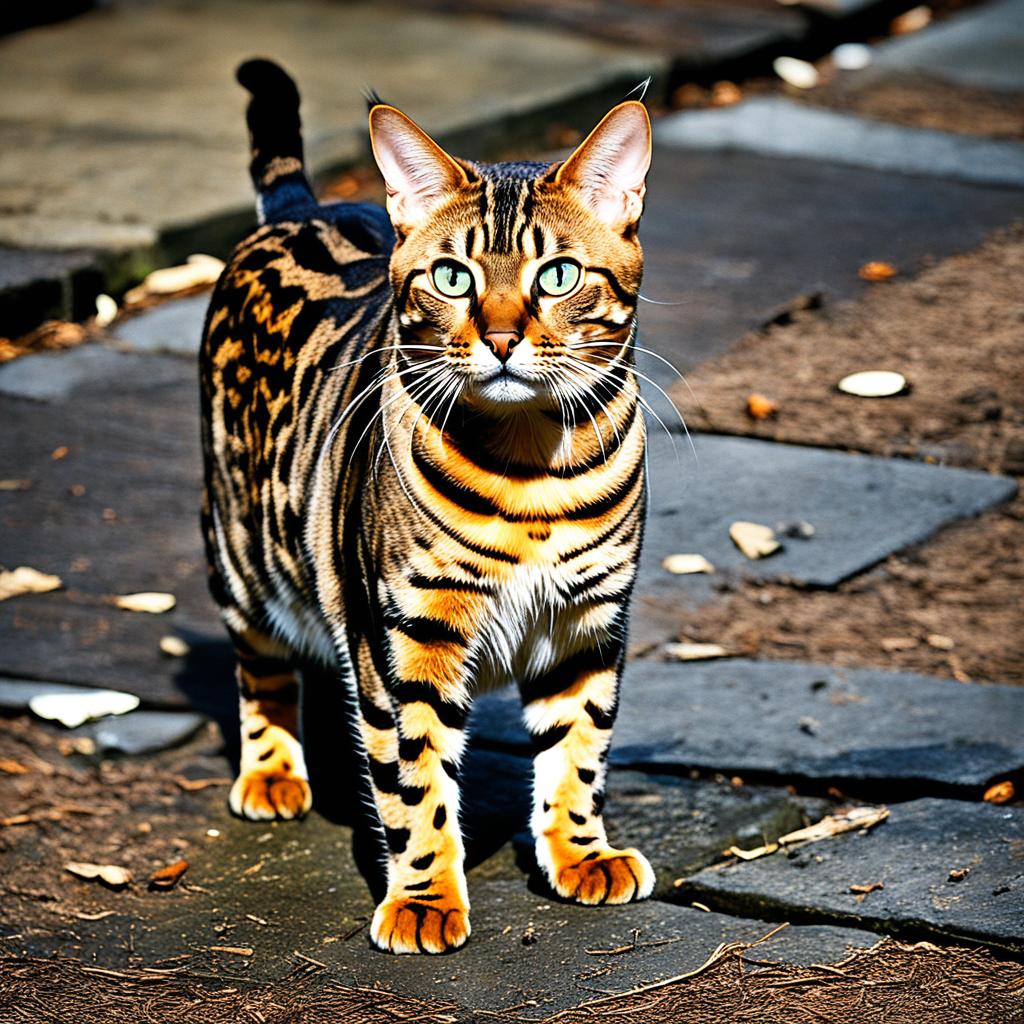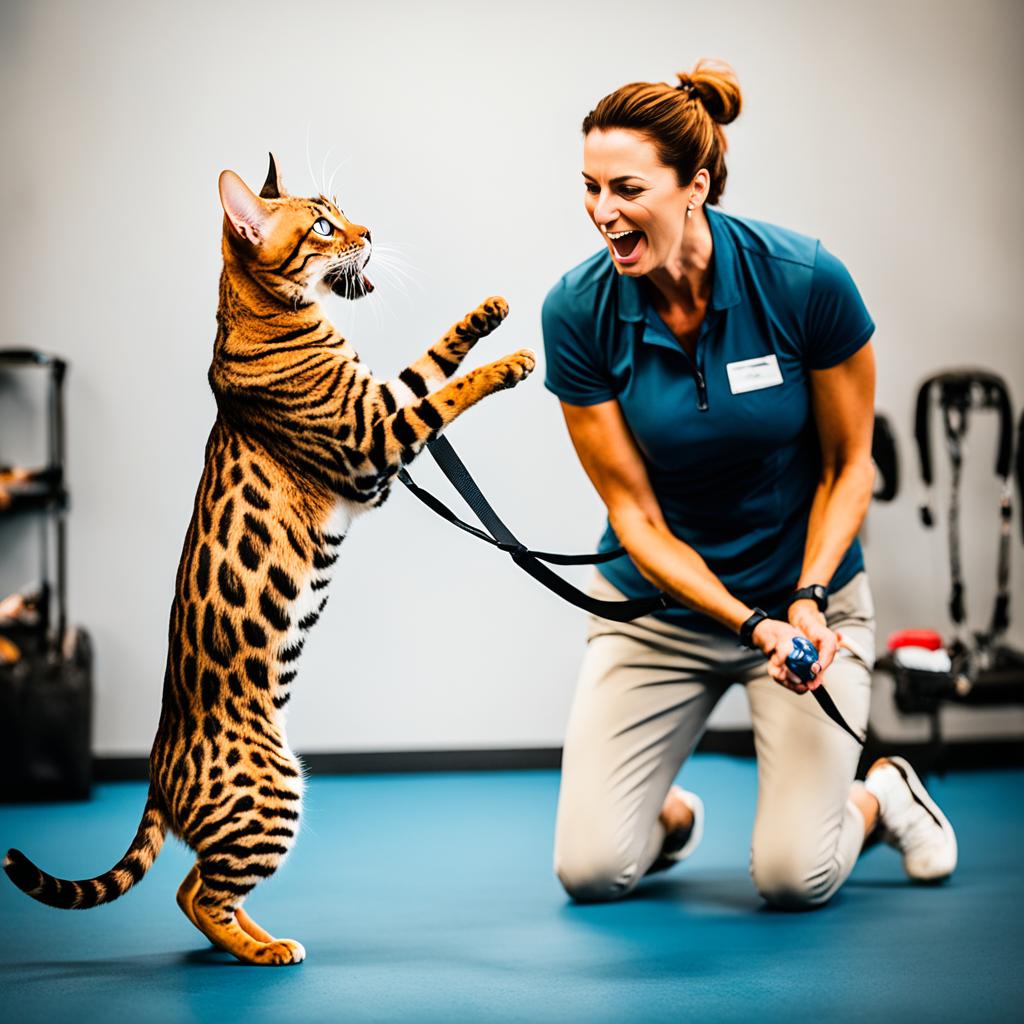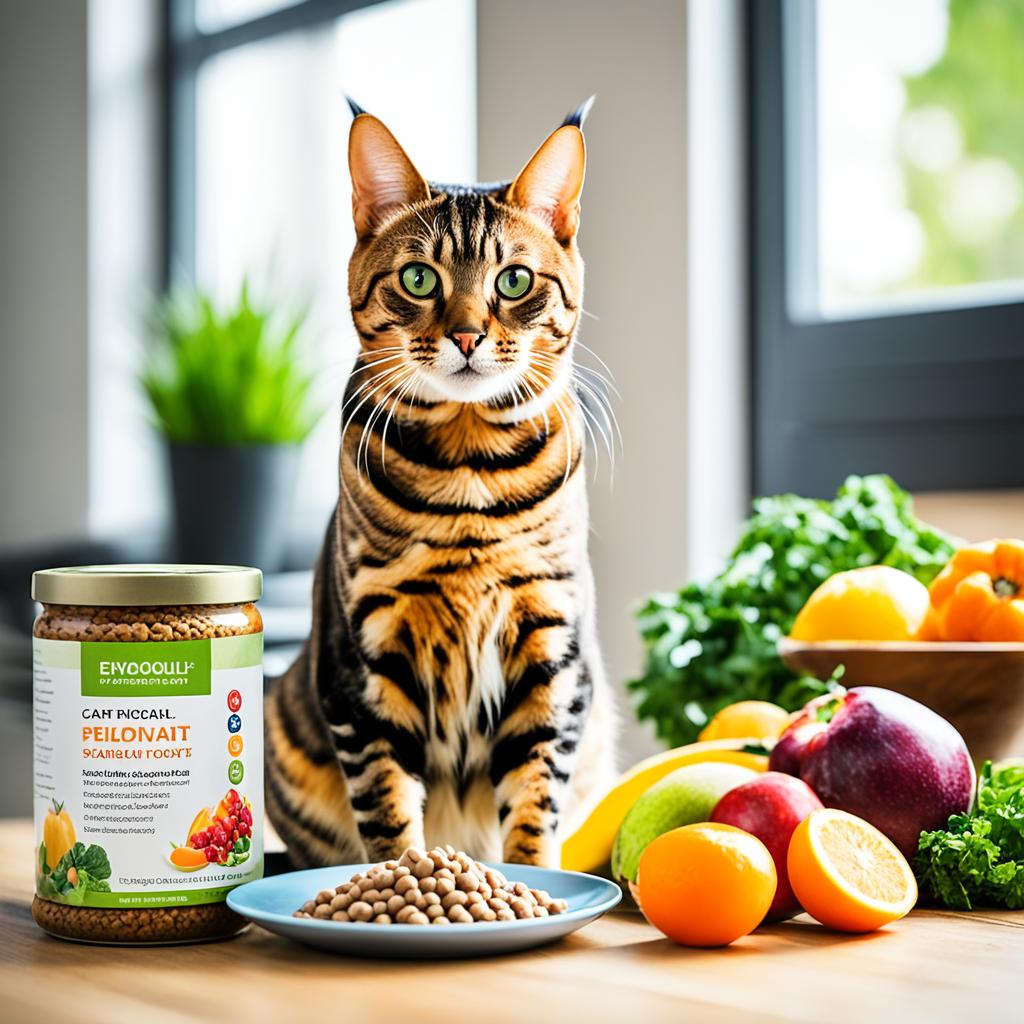Have you ever noticed your sweet Bengal cat acting like a mini tiger? Aggressive behavior in Bengals isn’t as complicated to deal with as it might seem.
Bengal cats are exciting mixes of the Asian leopard cat and home cats. They come with beautiful coats and lively personalities. But sometimes this energy turns into aggression when they’re not entertained or stimulated enough. This aggression can come from various sources like not having enough space, being scared, or even getting too rough during playtime.
However, there is good news. By giving your Bengal the right attention, enriching its environment, and meeting its unique needs, you can unlock even the wildest cat’s heart. One key step is to have your Bengal spayed or neutered. This greatly reduces their urge to mate and can calm them down.
To prevent or reduce this aggression further, always make sure your Bengal is mentally and physically active. Use fun toys, climbing trees, and spend quality time to keep them happy. By keeping them engaged and loved, you’ll enjoy a much smoother relationship with your feline.
Key Takeaways
- Understanding the unique mix of wild and domestic traits in Bengal cats is essential.
- Proper care and socialization can effectively manage aggressive behavior.
- Neutering can help reduce aggression by addressing mating instincts.
- Keeping your Bengal mentally and physically stimulated prevents boredom-induced aggression.
- Identifying and addressing the underlying reasons for aggression ensures a peaceful coexistence.
Understanding Bengal Cat Behavior Issues

Bengal cats stand out with their stunning looks and energetic spirits. Yet, their liveliness can lead to some behavior challenges. These cats need plenty of engagement because of their intelligence and unending curiosity. Understanding their actions and sounds is crucial for a calm co-existence.
Characteristics and Traits
Bengal cats have a strong hunt instinct from their wild heritage. This can make them seem aggressive at times. But really, it’s usually just them playing or showing confidence. They’re also quite chatty. Bengals enjoy having conversations and being vocal about their needs. This might create a wrong impression about their mood.
Common Behavioral Problems
Bengal cats might act out when they’re bored or feel under-stimulated. This can lead to issues like clawing furniture, too much noise, or even being aggressive over territory. It’s important to find the right balance for these cats. This means recognizing their wild side and offering suitable activities.
Starting their socialization early is vital for Bengal cats. Giving them the right toys and things to do can help prevent bad behaviors. Understanding what their sounds and actions mean is a great step. It allows you to meet their wants early, keeping your bond strong.
Causes of Aggression in Bengal Cats

Knowing why Bengal cats get aggressive will help you handle your pet better. Many things can make them act out, so finding the main cause is key. This way, you can choose the best way to calm your cat down.
Environmental Triggers
Things in their environment can set off Bengal cats. Moving to a new home, getting a new pet, or changing furniture can make them stressed. They are very picky about their spaces, so any change might make them act defensively.
Health-Related Issues
If Bengal cats are in pain, they may become more irritable and aggressive. It’s important to take your cat for regular vet checks. This can help catch and treat issues like arthritis early, which might make them lash out suddenly.
Genetic Factors
Aggression in Bengals can also come from their genes. Some cats might naturally be more pushy. Still, with good training, this trait can be turned into something positive. But, even experienced owners may find it challenging at times.
Understanding the reasons behind aggression in Bengal cats can lead to better handling. By knowing about their environment and health issues, you can ensure your cat is happy and well-behaved.
How to Handle Bengal Cat’s Aggression?

Dealing with a Bengal cat’s aggression can be tough. But, the right tips for dealing with aggressive Bengal cats can help you a lot. It’s key to know what makes your Bengal cat upset. This makes handling their aggression much easier. And using positive training can really make a difference.
Avoid punishment when your cat acts out. It can make things worse. Instead, use positive reinforcement. This means giving treats and praise when your cat is calm. It helps them learn what behavior is good.
Also, it’s important to understand your Bengal cat’s mind. Changing your own behavior can help them feel safe. Make sure they know the rules to avoid aggression. If they get too rough during play, distract them with toys.
Here are practical ways to lessen aggression:
- Keep a regular routine to lower stress.
- Use toys to keep them busy and focused.
- Give them quiet spots to go to when they feel overwhelmed.
Preventing aggression in Bengal cats is also about being proactive. Regular visits to the vet can stop health problems from causing aggression. And making their environment stress-free can help. It’s not about quick fixes. It’s about using strategies that match their needs and behavior.
Effective Training Techniques for Aggressive Bengals

Do you have a Bengal cat that’s full of energy? Dealing with aggression is key for peace at home. By learning and using the right training methods, your Bengal can become calm and well-behaved.
Positive Reinforcement Strategies
Rather than focusing on what not to do, we should reward the good actions. For aggressive Bengals, use rewards like treats or clicker training. This makes your home a positive place for both you and your feline friend.
“A well-timed treat can turn even the moodiest Bengal’s day around.” – Anonymous
Socialization Tips
Starting early with socialization is crucial. Let your Bengal meet many people and pets when they’re young. This helps them feel more sure of themselves and reduces aggressive fear. Remember, slow introductions to new animals prevent fighting and make things smoother.
- Start socialization early: Engage your kitten with various stimuli.
- Use gradual introductions: Prevent territorial disputes by keeping initial interactions short and supervised.
- Maintain consistency: Regular, engaging training sessions ensure continuous improvement.
| Technique | Benefit |
|---|---|
| Positive Reinforcement | Encourages good behavior without fear of punishment |
| Clicker Training | Helps establish clear communication and expectations |
| Early Socialization | Reduces fear-based aggression and builds confidence |
| Treat Rewards | Provides motivation and reinforces positive actions |
The Role of Diet in Managing Bengal Cat Aggression

Feeding your Bengal cat the right food is key to handle their aggressiveness. A diet packed with good food directly affects how they act. This can help lower any sudden angry moments.
Bengal cats are always on the move. So, a diet full of animal protein is crucial for their energy. This kind of protein is better for cats than plant-based ones. It gives cats all the amino acids they need to stay healthy.
Importance of High-Quality Protein
High-quality protein is very important for Bengals. Animal proteins from meat, chicken, or fish are best for them. These foods help their muscles grow strong and keep them healthy. Knowing this can change how your Bengal acts, making them less aggressive.
Dietary Factors to Monitor
Watching what your Bengal eats is more than seeing where the protein comes from. You also need to balance the right fats and carbs. Ideally, their meals should mostly be meat.
| Nutrient | Recommended Percentage |
|---|---|
| Animal Protein | Minimum 50% |
| Animal Fat | Maximum 20% |
| Carbohydrates | As low as possible |
A diet with top-notch proteins and the correct fats is great for Bengals. It keeps them physically fit and makes them less aggressive. By focusing on diet, you help your Bengal cat be calmer and easier to be around.
Importance of Mental and Physical Stimulation

Ensuring your Bengal cat stays active is key to prevent aggression. Bengals are very energetic and smart, needing activities that use their brain and body.
Interactive Toys and Games
Interactive toys help keep Bengal cats mentally sharp. Puzzle feeders, laser pointers, and moving toys mimic hunting. They entertain your cat and prevent boredom.
Exercise Routines
Physical activity is a must for Bengals to curb aggression. Activities like using a cat wheel, fetch, or walks help them use up their extra energy. A regular exercise plan makes sure your Bengal stays calm and happy.
| Activity | Benefits |
|---|---|
| Puzzle Feeders | Mental stimulation, reduces boredom |
| Laser Pointers | Engages hunting instincts, promotes exercise |
| Cat Wheel | Physical exercise, decreases aggression |
| Leash Walks | Provides outdoor exploration, physical activity |
Creating a Safe and Positive Environment for Your Bengal Cat
Your Bengal cat’s home is key to reducing bad behavior and keeping them happy. Making their space rich and safe does wonders for their mood. It’s all about creating a fun place for them with lots of safe spots.
Environmental Enrichment
It’s crucial to enrich Bengal cats’ homes to match their lively nature. This includes high resting places, posts for scratching, and places to hide. Such additions reflect their wild instincts, keeping them busy and happy. Add in stuff like puzzles and changing toys to turn their home into a playground. This not only cuts down on misbehavior but also ensures a joyful and healthy life.
Safe Spaces
Even the bravest Bengal cat can sometimes get scared or overwhelmed. That’s why it’s important to have special safe areas just for them. A quiet nook with a soft bed or a hidden box can be their escape spot. These places help them chill out when they’re upset or stressed, making them feel safe in their home.
It’s essential to focus on both enrichment and safe spots for Bengal cats. This approach boosts their life quality overall. Your Bengal’s joy and health are greatly influenced by a well-prepared and caring environment.




